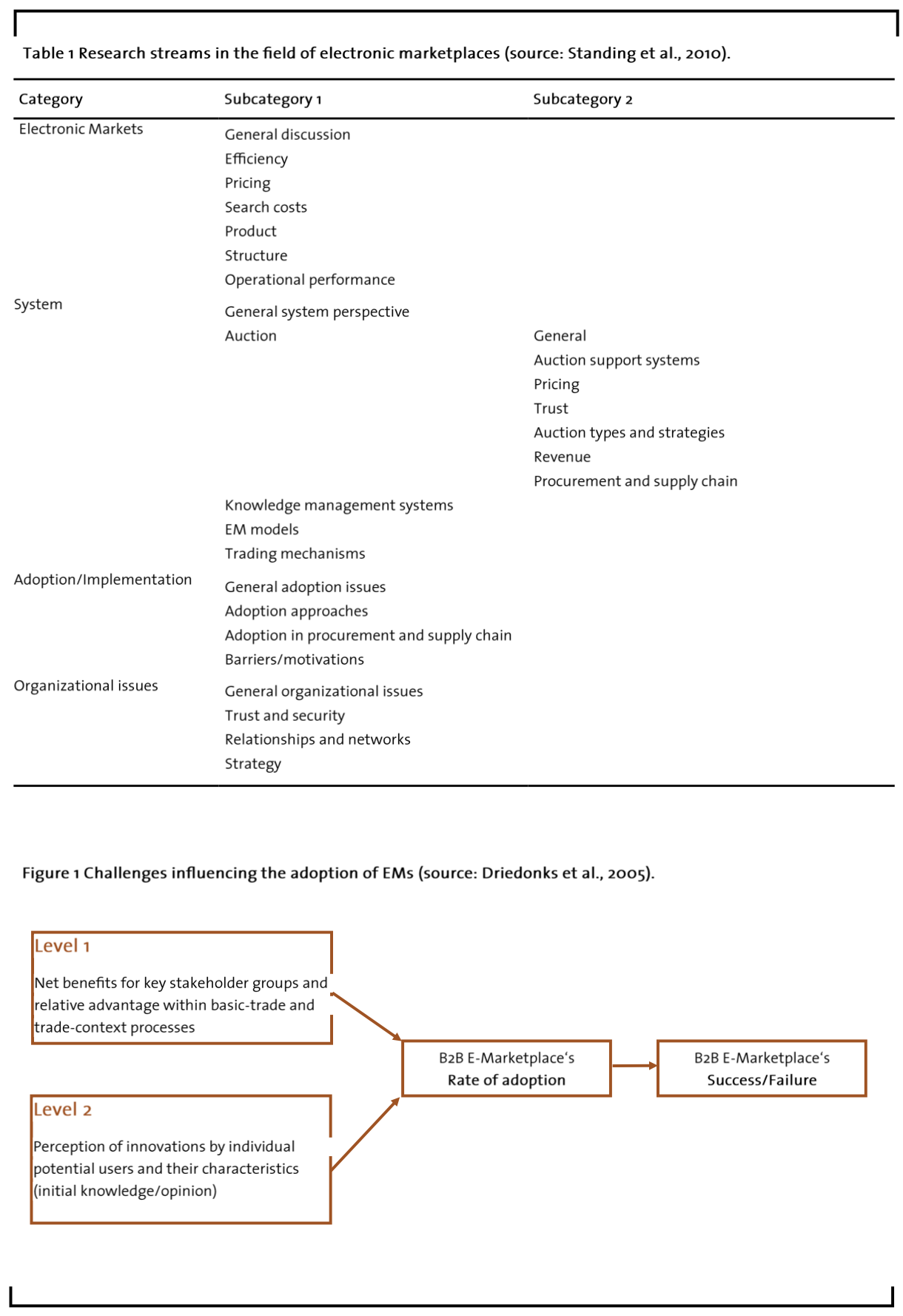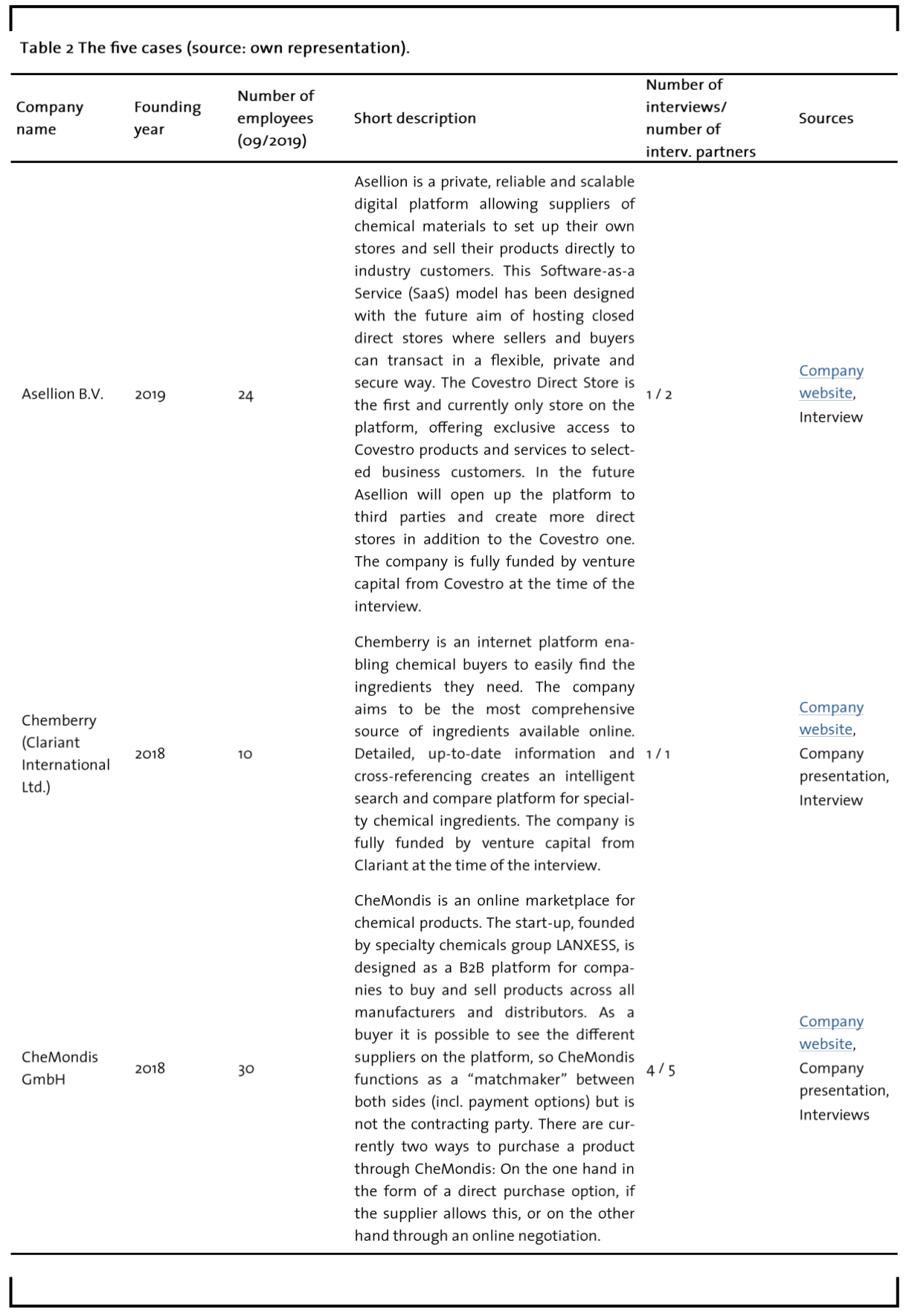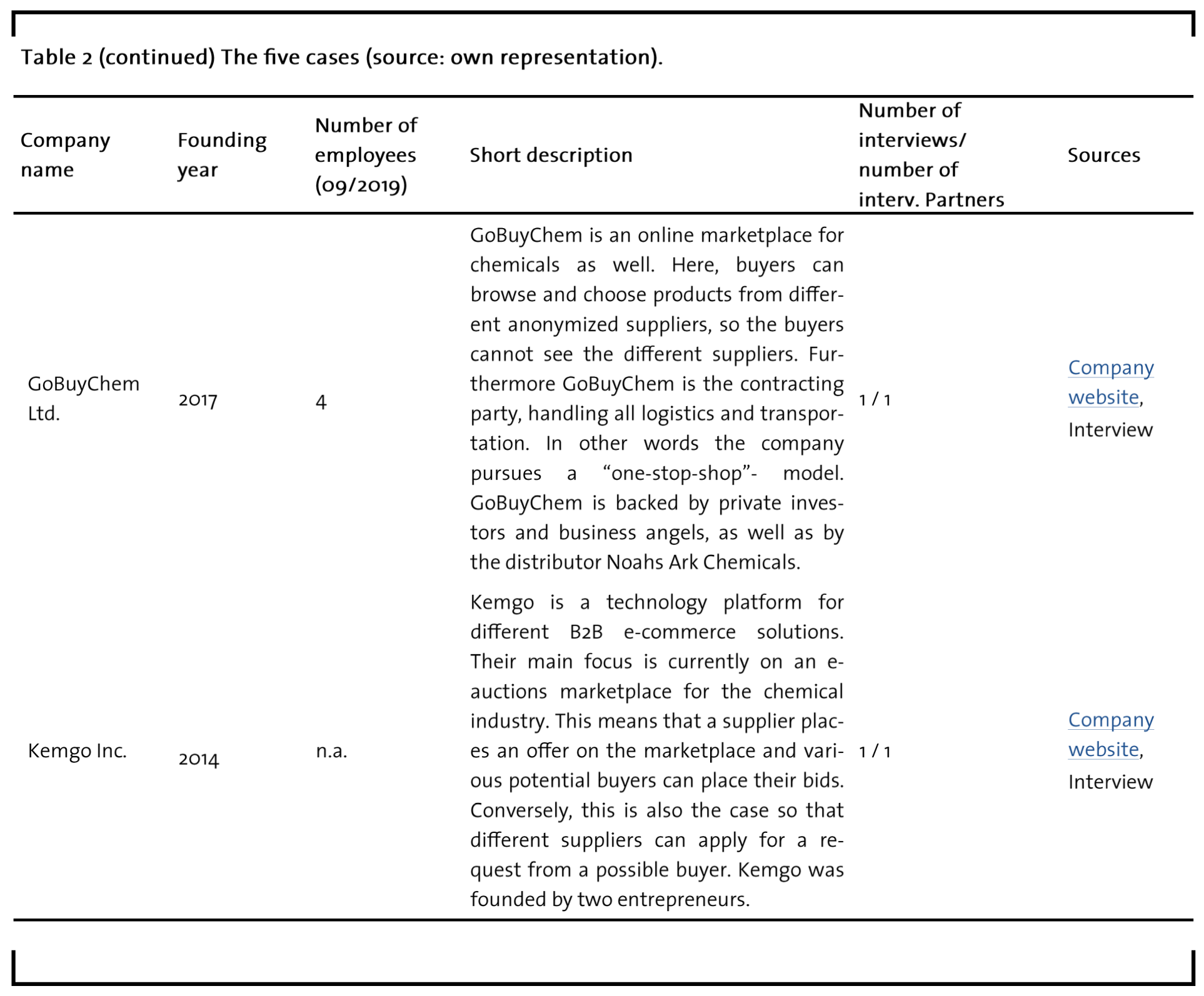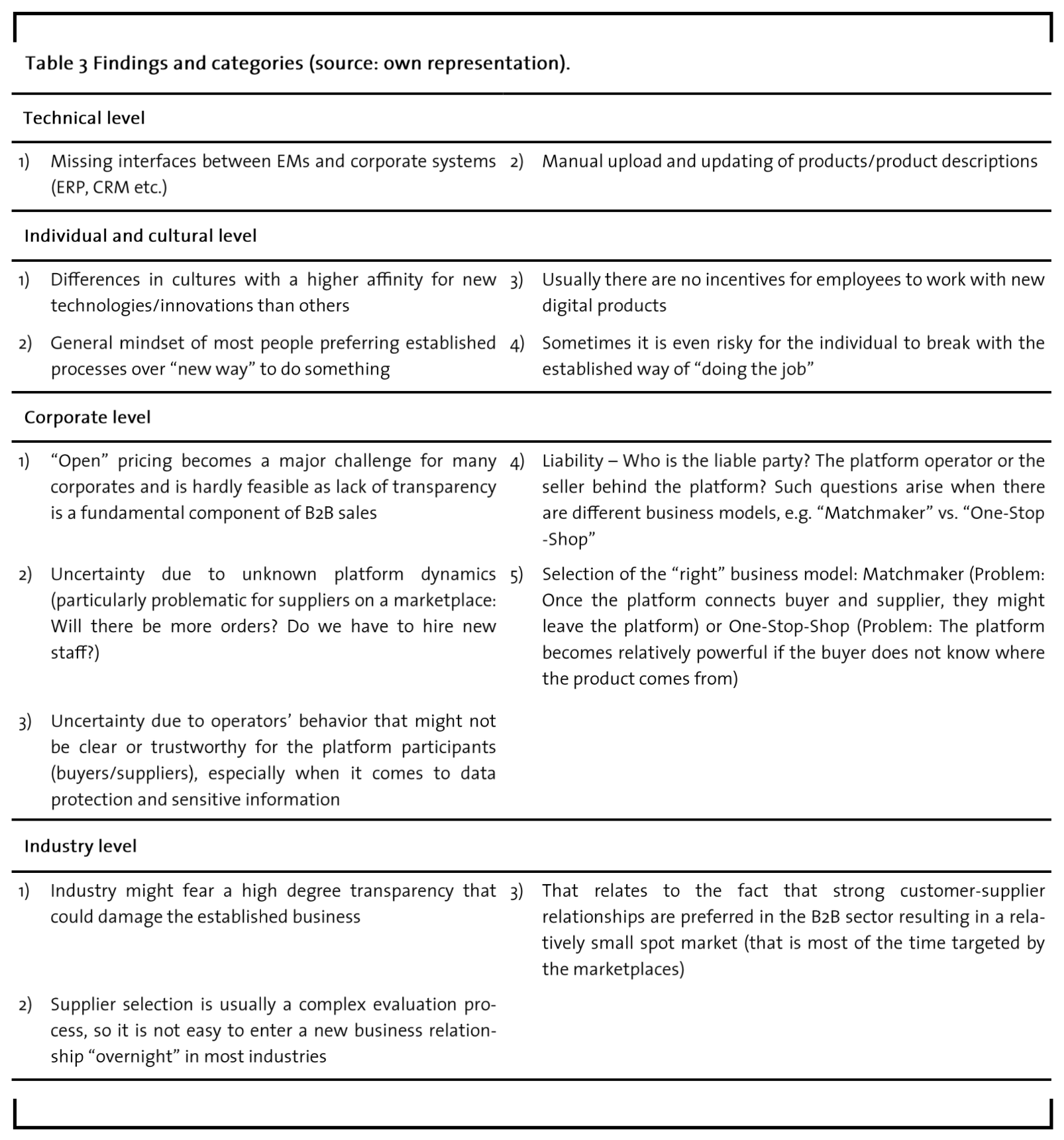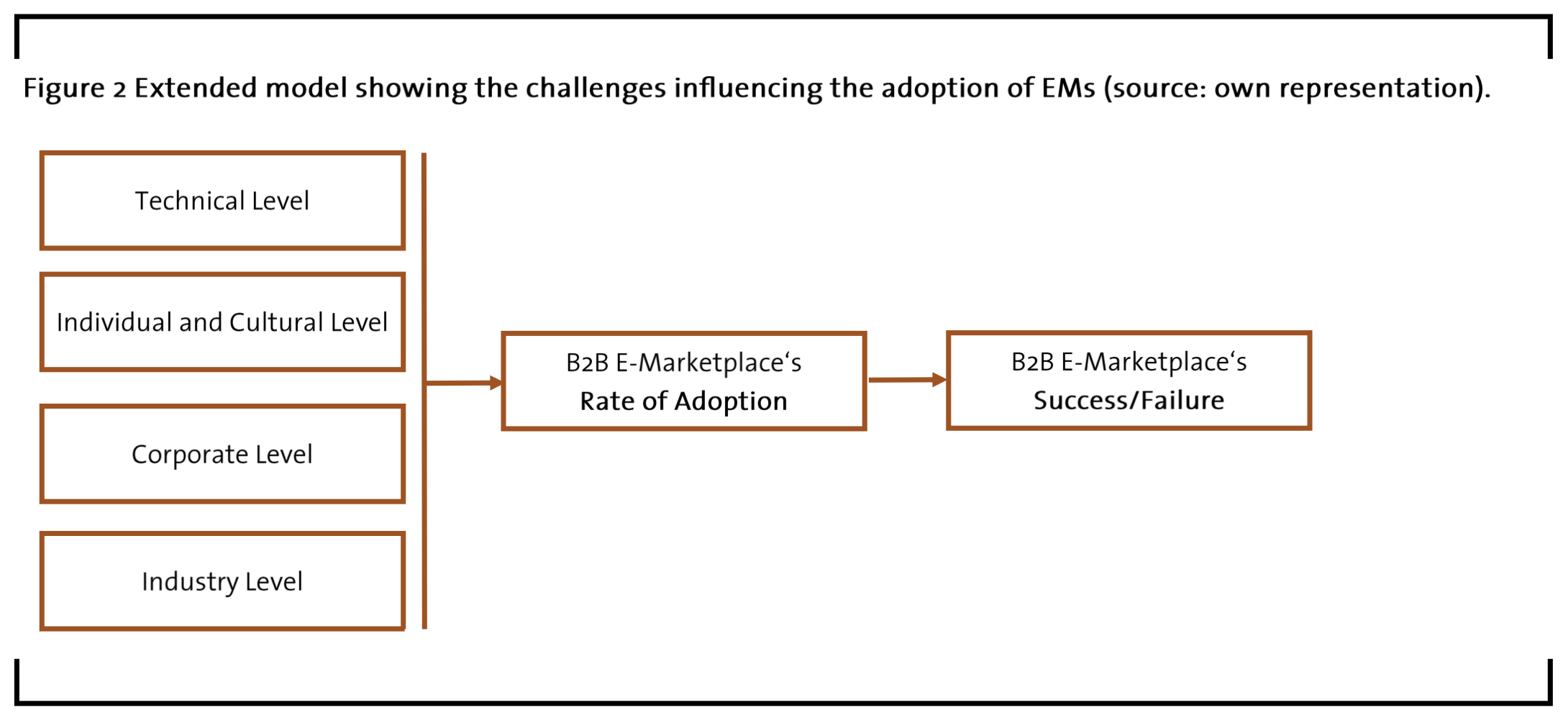Challenges affecting the adoption of B2B electronic marketplaces
Abstract
Almost 20 years after the bursting of the dot-com bubble, we are again experiencing a boom in B2B electronic marketplaces. These marketplaces usually connect buyers and suppliers in the digital sphere; however, the implementation of a marketplace comes with numerous challenges in the B2B sector. Marketplace operators often reach their limits, especially at the operational level. Based on expert interviews with five electronic marketplaces from the chemical industry and from other data sources, we have collected these challenges and classified them into four categories: (1) Technical Level, (2) Individual & Cultural Level, (3) Corporate Level, and (4) Industry Level. The categories presented in this case study extend an existing research model that deals with the adoption of B2B electronic marketplaces. This theory development provides a deeper understanding of electronic marketplaces, which is important for both researchers and practitioners. The mastering of these challenges has a major influence on the adoption of the respective marketplace as well as on its success or failure.
1 Introduction
During the dot-com bubble period, internet-based companies received a lot of funding through high investments that later turned out to be extremely speculative (Day et al., 2003). The bubble was created between 1995 and 2000, shortly after which it burst and went down in history as one of the most legendary stock market crashes of all time (ibid.). During the dot-com boom, numerous B2B electronic marketplaces (EMs) were created, most of which disappeared from the market during the crash or a short time later. Companies such as Chemdex, Chematch, or ChemConnect were well-known B2B EMs in the chemical industry at that time (Tedeschi, 2001; Glick, 2001; Kane, 2002). Almost 20 years later, we are experiencing a new boom in this industry with companies such as CheMondis, Chemberry, GoBuyChem, KEMGO, and Asellion (CHEManager, 2019). While these “new” B2B EMs share commonalities, they also exhibit differences. All companies focus on the chemical industry and pursue a marketplace model that aims to bring together buyers and suppliers of chemical substances. This makes them competitors, as well as interesting objects of investigation. A crucial success factor for every EM operator is the adoption of the marketplace in its specific community or industry, which can be defined by the regular use of the marketplace through the respective user groups, who can be grouped into buyers and suppliers (Driedonks et al., 2005).
Coming back to the chemical industry, the marketplace model represents an innovation since aspects that are still perceived as new for this very traditional industry accompany this model. For instance, EMs achieve a certain transparency and comparability through their platform character (ideally many buyers and many suppliers). We are already interacting with this scenario from the B2C context when we make purchases privately on marketplaces such as Amazon, where we can compare products and prices from different manufacturers or retailers. In the B2B sector, this transparency does not yet exist in many industries. This also applies to the chemical industry, where prices for chemicals are usually negotiated between buyers and sellers.
In the course of digitalization, the importance of B2B EMs is again increasing, as many of the current activities focus on the customer or the (end-) user. From the point of view of the B2B buyer (e.g., a procurement manager), the aforementioned transparency would be a desirable development. From the supplier’s point of view, however, EMs represent, in most cases, a threat to the established business. B2B EMs therefore pose different challenges regarding their adoption than B2C EMs. The latter have been investigated intensely in research, which is probably due to the success of Amazon (Alt and Zimmermann, 2019).
In this paper, we discuss the challenges of B2B EMs by applying the grounded theory approach formulated by Glaser and Strauss (1967) to the five chemical marketplaces mentioned above. With this research, we contribute to the field of digital business and e-commerce, and, more precisely, to the field of electronic marketplaces and their adoption. We will start by presenting the current state of the literature and explaining the methodology in detail. We will then introduce our case study, which contains the main challenges regarding the implementation of B2B EMs from the perspective of the marketplace operators, and discuss the extension of an existing scientific model from Driedonks et al. (2005) for the adoption of B2B marketplaces. Finally, we will conclude with the limitations of our study and the implications for future research.
2 Theoretical background
Electronic Marketplaces (EMs, also “Electronic Markets,” “E-Markets,” “E-Hubs”, “Two-sided platforms”) received a lot of attention from researchers at the time of the dot-com boom and the years that followed. Among several definitions that arose during that period, Archer and Gebauer (2002, p. 1 f.) describe EMs as “virtual marketplaces where buyers and suppliers meet to exchange information about prices and product and service offerings, to collaborate, and to negotiate and carry out business transactions.” EMs can also focus on the B2B sector by allowing business partners such as suppliers and buyers to communicate and conduct business transactions (Timmers, 1998; Chow et al., 2000).
The desire to categorize EMs has remained unbroken ever since, especially when closer attention is paid to the features and functions of an EM, where you can differentiate between exchange, auction, or aggregator (ibid.). Kaplan and Sawhney (2000) suggest categorizing B2B EMs according to their product portfolio and whether EMs perform correspondingly as horizontal or vertical markets. Others focus more on the dynamics and mechanisms inside an EM, e.g., by focusing on the aspect of competition on a platform (Kollmann, 2000; Holland, 2002; Belleflamme and Peitz, 2019), on pricing strategies and information transparency (Yoo et al. 2002; Soh et al. 2006; Zhu, 2004) or on the evolution of an EM (Tomak and Xia, 2002, Thuong, 2005).
Day et al. (2003, p. 132 f.) elaborate on the distinctions by regarding the functions as well: “These exchanges offer various combinations of six core services: (1) information exchange, (2) digital catalogues that help to automate the procurement process, (3) auctions that attract large numbers of suppliers to compete for contracts, (4) logistics services to facilitate the physical movement of goods, (5) collaborative planning so different members of a supply chain can view each others’ inventory levels and production schedules, and (6) value-added services such as design collaboration, financing or offline brokering.”
The pioneers of the research field might be Malone et al. (1987, p. 488), who said that EMs “electronically connect many different buyers and sellers through a central database.” Shortly before the bursting of the dot-com bubble, Choudhury (1997) added that EMs are “inter-organizational systems through which multiple buyers and suppliers interact to accomplish one or more of the following market-making activities: (1) identifying potential trading partners, (2) selecting a specific partner, (3) executing the transaction.” Another definition from Standing et al. (2006, p. 297) again focused more on the B2B sector: “In its simplest form a B2B e-marketplaces can be defined as an inter-organizational information system that allows the participating buyers and sellers in some market to exchange information about prices and product offerings. Indeed, e-marketplace structures are complex and vary considerably according to the market maker’s business strategy.”
Following these general definitions of EMs, we would like to point out the different research streams existing in this field of research, in order to make clear where our contribution lies. Standing et al. (2010) categorize the literature into the following categories and subcategories (see Table 1). One limitation noted by the authors is the focus on scientific journals located in the area of information systems. They only included one journal outside the field of information systems, which was Management Science.
With our research, we mainly contribute to the research stream “adoption of (B2B) electronic marketplaces,” where the key research question is: What affects the adoption of B2B EMs and how can the factors influence the possible success or failure of EMs? In other words, it is about the decision of the EM user to adopt the “new way of B2B trading” (Driedonks et al. 2005, p. 50). The research stream on the adoption of EMs is based on different theories like the technology adoption theories, such as diffusion of innovation theory and technology acceptance model, as well as on other theories, such as social network theory, transaction cost theory, or resource dependence theory (Bakos, 1997; Wang, 2008; Luomakoski, 2012). Driedonks et al. (2005) define the rate of adoption as “the relative speed with which an innovation is adopted by members of a social system, which is generally measured as the number of individuals who adopt a new idea in a specified period, such as each year.” In this paper, we take the same position as these authors and understand adoption “as the range of behaviors from the decision to use an innovation to full and regular use of it, and rejection means the decision not to use the innovation at all” (Driedonks et al. 2005, p. 50 ff.). The success or failure of an EM is closely related to the rate of adoption, which was addressed strongly by researchers at a “high level” that is quite far away from the operational level that platform operators face in their daily business. For this reason, we focused on this operational level.
Driedonks et al. (2005) show this in a case study on the Australian beef industry, in which a marketplace emerged at the time of the study. They distinguish between two levels that influence the rate of adoption of an EM (see Figure 1), which will be the basis for our (extended) research model: Their Level 1 deals with the key stakeholders that should achieve a relative advantage by using the EM, always compared to existing (perhaps non-digital) transaction processes. Their Level 2 focuses on the actual user of the EM and, in particular, his or her (previous) knowledge and perception of the EM. Both levels or aspects have an influence on the adoption rate of the EM, from which it can be derived whether the EM will be a success or a failure.
3 Methodology
The abductive approach describes a research process that mostly begins with “surprising facts” or “puzzles” that should be explained. These may emerge when a researcher encounters an empirical phenomenon that cannot entirely be explained by the existing range of theories (Saunders et al., 2012). In our study, the empirical phenomenon is the almost simultaneous emergence of B2B marketplaces in the chemical industry and whether they are adopted by their specific community or industry. Following this abductive approach, we propose a model that contains the main challenges regarding the implementation of B2B EMs from the perspective of the marketplace operator. The abductive approach can be viewed as a combination of deductive and inductive approaches. Deductive approaches deal with the development of propositions from current theory, which should be tested later in the real world (Yin, 2013). Inductive approaches rely on “grounded theory” (Glaser and Strauss, 1967), where theory is systematically generated from data. According to Glaser and Strauss (1967), there is a continuous iteration between empirical data collection and data analysis, which allows the generation of theory. In this paper, our research follows an inductive rather than a deductive approach, as we first dealt with data collection. At the same time, we were aware of current theory. After the data analysis, we were able to extend the model of Driedonks et al. (2005).
The main source of data are semi-structured expert interviews with company representatives (see Table 2). The objective of the interviews was to collect the main challenges of B2B EM operators in the chemical industry. In order to deal with a homogenous sample, only cases that follow a marketplace model in the chemical industry and are active in Europe were selected for this research. A total of eight interviews were conducted, in which ten experts from five companies were involved. These five companies represent around half of the population of chemical marketplaces that are active in the European market (Von Hoyningen-Huene, 2019). The interview partners were the CEOs, managing directors, or senior managers of the respective companies. The interviews took place on the phone or on site between January and August 2019. Each interview lasted between 30 and 60 minutes (total: ~5h). The interviews were transcribed and later analyzed with a focus towards the challenges of the platform operators expressed by the interview partners.
This resulted in four categories, which will be explained in the next section. Each challenge could be assigned to one of these categories. Secondary data was collected from company presentations, company websites, and newspaper articles. These sources mainly contained information about the participating companies (e.g., for the case descriptions) and about the industry in general as the context is quite relevant here. Additionally, we used newspaper articles for the introductory part (e.g., historical background). Due to the various data sources and the different companies involved, our paper follows a multiple case study approach.
4 Findings
In the course of the interviews, four different categories emerged into which the challenges of the EMs examined can be classified. We labeled these categories as follows: Technical Level, Individual and Cultural Level, Corporate Level, and Industry Level. We have assigned the respective challenges to these categories. Table 3 represents our main findings from the interviews.
The challenges of B2B EMs can be classified into four categories. At the technical level (1), there might be interface problems with existing and established systems that are already used internally (e.g., ERP, CRM). The manual upload of products to the EM or the updating of product information is also an additional effort.
The basic goal of EMs to accelerate the trade and make it more efficient can already fail at this level. At the individual and cultural level (2), it might become challenging as well: depending on the cultural area, there may be tendencies towards a higher or lower affinity with regard to the adoption of new technologies and innovations. In addition, humans seem to prefer established processes to unfamiliar and new processes. In terms of the work context, there is often a lack of incentives for an employee to take up the challenge of new digital solutions. If an employee suggests new (digital) processes, this can even be risky and, in the worst case scenario, can lead to bad team dynamics or related problems. For this reason, a bottom-up approach appears less likely than a top-down approach. Thus, managers need to approve the new technology/innovation before the operative staff is going to work with it.
The corporate level (3) also brings various challenges: If the transaction should take place on the EM, prices must be fixed or negotiated there. Fixed prices that are open and thus visible to the user of the platform pose a problem for many suppliers in the B2B sector. They are worried that price transparency will threaten the established business and that the potential customer will make their decision based only on price. In addition, there are various uncertainty factors. On the one hand, it is difficult for suppliers to predict how many new leads or customers can be generated through the EM. If many new requests arise, new employees might have to be hired to serve them. On the other hand, the behavior of the platform operator is difficult to predict. What exactly happens to the data generated on the EM and is it always used to the advantage of all EM participants? Unresolved questions reduce the adoption rate, especially in the B2B area, where highly sensitive data is often involved. Furthermore, the question of liability and the appropriate business model arises. If the EM functions as a “matchmaker,” the EM is openly bringing the demand and the supply side together, without necessarily being the contracting party. If the EM follows the model of a “one-stop-shop”, the EM is the contracting party. Both the “Matchmaker Model” and the “One-Stop-Shop Model” have advantages and disadvantages for the EM operator as well as for the EM participants.
When it comes to the industry level (4), transparency about prices, products, and suppliers is particularly problematic for the supply side. This transparency is, at the same time, one of the core value propositions of an EM from the buyer’s perspective. In traditionally oriented industries, such as the chemical industry, transparency-creating EMs therefore reach their limits. Another characteristic of B2B transactions in general is the pre-qualification and evaluation of suppliers. These processes are usually time-consuming and complex. EMs that focus on the transaction should therefore pay attention to industry-specific requirements. Another characteristic of the B2B sector is the general preference for strong firm-supplier-relationships. The so-called spot market for fast and unforeseen demand can therefore vary significantly in size from industry to industry. This raises the question of whether EMs always address the spot market or whether they generally try to cover the entire trading of an industry. The last aspect goes hand in hand with the hypothesis that all trade will take place digitally in the future.
5 Discussion and conclusion
Based on the study of Driedonks et al. (2005) and our findings, we propose an extension of their research model with the following steps: We suggest naming their Level 1 “Corporate Level” and their Level 2 “Individual and Cultural Level”. We also suggest adding the “Technical Level” and the “Industry Level” to the model because these aspects are equally important but are yet to be treated. Our additions allow a broader view of the aspects that influence the adoption of a B2B EM and, consequently, also address a gap within this research stream. This is our contribution to the theory development (see Figure 2). Derived from the rate of adoption, a statement can be made about the success or failure of the respective EM.
6 Limitations and future research direction
There are limitations to the present study and the associated results. B2B EMs from the chemical industry may not, or only partially, be able to deduce B2B EMs in other industries. As far as our four categories are concerned, the classification of the findings is not always possible as there are overlaps between the categories. An interesting research approach would be, on the one hand, a process study that covers the development of B2B EMs over time, e.g., with regard to the number of participants or the possible revenue streams. On the other hand, in this study we have dealt intensively with the challenges that the platform operators are trying to solve with various activities. Another possibility for future research would therefore be to counter the challenges with the possible solutions . Since the field of EMs is regarded as very interdisciplinary, the literature categories and subcategories mentioned at the beginning of the paper can certainly be further developed. With regard to the economic effect of B2B EMs, it might also be interesting to examine their impact on an industry in general (e.g., patent applications, network effects). Assuming that B2B EMs simplify and accelerate access to new materials and products, EMs could have an impact on an industry’s ability to innovate.
7 Implication for practitioners
Managers and entrepreneurs in the process of establishing (or planning to establish) a B2B electronic marketplace face various challenges. A profound analysis needs to be carried out during (or ideally before) the implementation of such platform activities. The levels mentioned above can serve as a guideline for this analysis. Each level should be dealt with intensively, for example, through methods such as customer and user interviews, stakeholder analysis, resource analysis, or ecosystem mapping. Based on the collected insights, a decision should then be made about whether and in what form a marketplace could be suitable for the respective industry. In most industries, there are already numerous highly specialized actors performing the key functions of the potential new marketplace (e.g., product catalogues, brokerage services, logistics services, financial services). The aim of the possible EM should be to aggregate these numerous offers and services and to provide them to the demand side from a single source.
References
Alt, R. and Zimmermann, H.-D. (2019): Electronic Markets on platform competition, Electronic Markets, 29: 143-149.
Archer, N. & Gebauer, J. (2002): B2B Applications to Support Business Transactions: Overview and Management Consideration. In Business-to-Business Electronic Commerce: Challenges and Solutions, Idea Group Publishing.
Bakos, Y. (1997): Reducing Buyer Search Costs: Implications for Electronic Marketplaces, Management Science, 43 (12). 1676-1692.
Belleflamme, P. & Peitz, M. (2019): Managing competition on a two-sided platform. Journal of Economics & Management Strategy, 28:5-22. Wiley Periodicals Inc.
CHEManager (2019): E-Commerce Platforms in the Chemical Industry. CHEManager International, Available at https://www.chemanager-online.com/en/topics/information-technology/e-commerce-platforms-chemical-industry-0 , accessed 17 September 2019.
Choudhury, V. (1997): Strategic Choice in the Development of Inter-Organisation Information System, Inform. Syst. Res., 1997, 8(1), 1–24.
Chow, D., Ghani, A., Miller, M., Takeda, G. & Ziffru, S. (2000): B2B – Beyond the Market Hubs.
Kellogg Graduate School of Management Working Paper, Northwestern University.
Day, G., Fein, A. & Ruppersberger, G. (2003): Shakeouts in Digital Markets: Lessons from B2B Exchanges, Californian Management Review, 45(2), 131-150.
Driedonks, C., Gregor, S., Wassenaar, A. & van Heck, E. (2005): Economic and Social Analysis of the Adoption of B2B Electronic Marketplaces: A Case Study in the Australian Beef Industry, International Journal of Electronic Commerce, Spring, Vol. 9, No. 3, pp. 49-72.
Glaser, B. & Strauss, A. (1967): The Discovery of Grounded Theory, Strategies for Qualitative Research, Aldine Publishing Company.
Glick, B. (2001): Chemdex fell through a lack of user support. Computing, available at https://www.computing.co.uk/ctg/news/1845424/chemdex-fell-lack-user-support , accessed 17 September 2019.
Holland, C. (2002): Competition and Strategy in Electronic Marketplaces, Proceedings of the 35th Hawaii International Conference on System Sciences.
Kollmann, T. (2000): Competitive Strategies for Electronic Marketplaces, Electronic Markets, 10:2. 102-109.
Kane, M. (2002): Leap of faith – Why B2B went bust. C-Net, available at https://www.cnet.com/news/leap-of-faith-why-b2b-went-bust/, accessed 17 September 2019.
Kaplan, S. & Sawhney, M. (2000): E-Hubs – The News B2B Marketplaces, Harvard Business Review.
Luomakoski, Jari (2012): Why Did Electronic B2B Marketplaces Fail? – Case Study of an Agricultural Commodity Exchange, Dissertation.,University of Jyväskylä, Finland.
Malone, T., Yates, J. & Benjamin, R. (1987): Electronic Markets and Electronic Hierarchies, Comm. ACM, 1987, 30(6), 484-497.
Saunders, M., Lewis, P. & Thornhill, A. (2012): Research Methods for Business Students 6th Edition, Pearson Education Limited.
Standing, C., Love, P., Stockdale, R. & Gengatharen, D. (2006): Examining the Relationship between Electronic Marketplace Strategy and Structure, IEEE Trans. Eng. Manage., 53(2), 297-311.
Standing, S., Standing, C., Love, P. (2010): A review of research on e-marketplaces 1997-2008, Decision Support Systems 49. 41-51.
Soh, C., Markus, M. & Goh, K. (2006): Electronic Marketplaces and Price Transparency –Strategy, Information Technology, and Success, MIS Quarterly Vol. 30. 705-723.
Timmers, P. (1998): Business Models for Electronic Markets. Electronic Markets, 8:2. 3-8.
Tedeschi, B. (2001): Business to Business – Why Purchasing Agents Turned Out to Be Hard to Herd. The New York Times, Aavailable at https://www.nytimes.com/2001/02/28/business/business-to-business-why-purchasing-agents-turned-out-to-be-hard-to-herd.html, accessed 17 September 2019.
Thuong, L. (2005): Business-to-business electronic marketplaces: evolving business models competitive landscape, International Journal of Services Technology and Management, Vol 6, No 1.
Tomak, K. & Xia, M. (2002): Evolution of B2B Marketplaces. Electronic Markets, 12:2. 84-91.
Von Hoyningen-Huene, J. (2019): Disrupting Chemical Sales – The Rise of Online Marketplaces. CHEManager International, available at https://www.chemanager-online.com/en/topics/chemicals-distribution/disrupting-chemical-sales-rise-online-marketplaces, accessed 17 September 2019.
Wang, S., Zheng, S., Xu, L., Dezheng, L. & Meng, H. (2008): A Literature Review of Electronic Marketplace Research: Themes, Theories and an Integrative Framework, Springer Science.
Yin, R. (2013): Case Study Research and Applications: Design and Methods, 5th Edition. Sage Publications.
Yoo, B., Choudhary, V. & Mukhopadhyay, T. (2002): Pricing Strategies of Electronic B2B Marketplaces with Two-Sided Network Externalities, Proceedings of the 35th Hawaii International Conference on System Sciences.
Zhu, K. (2004): Information Transparency of Business-to-Business Electronic Markets: A Game-Theoretic Analyses, Management Science 50 (5). 670-685. September 2019.
